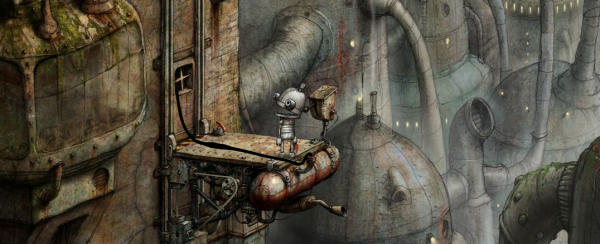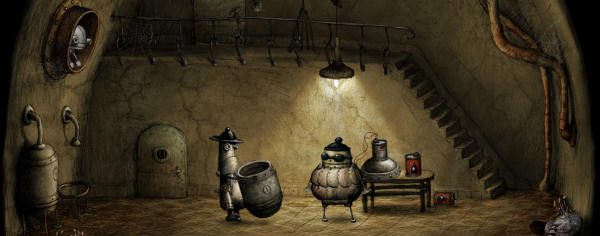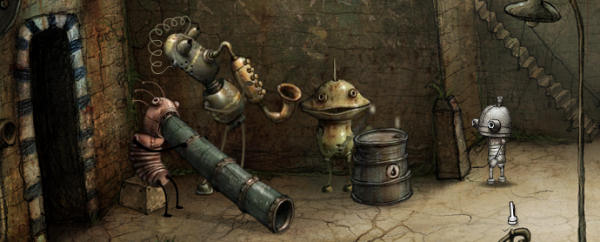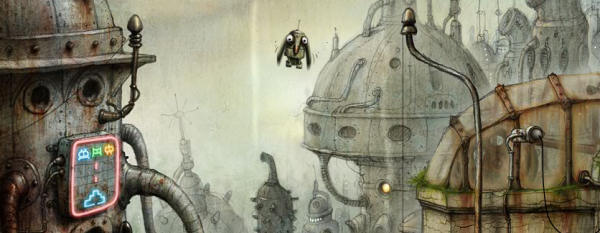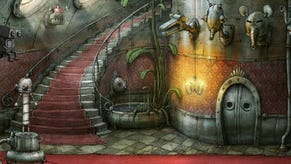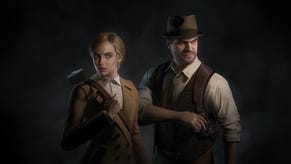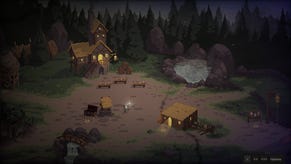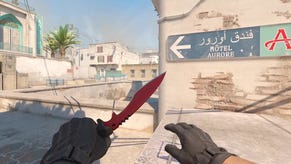Wot I Think: Machinarium
The long awaited adventure Machinarium is finally available today. After staring in wonder at the artwork and trailers for months I was able to play through a finished version this week in order that I could tell you Wot I Think.
Machinarium is an extraordinarily beautiful creation. It’s a sort of beauty that games are almost never graced with. The awesome panoramas of a Crysis or a Far Cry 2 can be remarkable, but it’s always technically remarkable. The gorgeous graphics of games like the recent Prince of Persia or the forthcoming Borderlands are artistic works, imaginative and fresh. But Machinarium’s scratchy, hand-drawn robot world is beautiful.
If you’ve played Samorost 1 or 2 you’ll already know something of the worlds creator Jakub Dvorský designs. Where those games combined his adorable cartoons with organic real-world collage, Machinarium’s point and click adventuring is entirely hand-created. Each location is breath-taking – as in, every time I walked to a new scene I sharply drew in breath in wonder. Elaborate rooms bursting with intricate detail, alive with charm, ready to be explored.
The protagonist is a small, adorable robot. He has been thrown out of the city, and your task is to get him back in again. Any other goals grow organically once you’re inside. These might be aiding a group of busking robots to restore their instruments, or helping an elderly robot to oil his broken wheelchair, each contributing toward the next, making a path to your final goal. Much of it is about puzzle solving, either collecting and combining objects and using them in the correct place, or literal puzzles: lever challenges, a board game, even some arcade challenges.
Early stages play out as a series of scenes, each to be solved until you can access the next. But a third of the way through Machinarium blossoms out into a much larger world. Once in the city you have a hub area with many directions to head in, puzzles solved in one vital for progress in another. In many ways, it’s a traditional point and click adventure.
And one of those traditions is quite how hard it can be. Success is about exploration and experimentation. The opening puzzle requires you to disguise yourself as a guard robot to gain access to the city. But first you must figure out that this is what the game wants you to do. As a long-time adventure game player it’s an instinctive notion, and emulating a disguise from the surrounding objects has been the solution to dozens of games’ puzzles over the years. But I wonder how instinctively painting a traffic cone and stealing a light bulb will come to those who didn’t have such irrational logic etched into their brains as a child.
However, to ensure no one is stuck for long Machinarium offers two levels of hints. Most scenes will have a very simple clue available by clicking the bulb that appears in the top menu. A thought bubble will appear with a simple sketch indicating the key action that needs to be taken. If you’re still stuck after that, there’s a clue book that can be clicked on which will offer a detailed pictorial guide for what that location requires of you. However, to prevent lazy peeking, the book is itself a little arcade game. You must guide a key through a side scrolling hazardous route, dodging the rocks and firing at enemy spiders, until you reach a keyhole. Er, yes. Do this and the walkthrough is yours. It’s not difficult, but it’s time consuming, and it’s one of the best ways to put you off cheating I’ve seen. And I should add, some of the puzzles are brilliant. The butterfly wing/slide projector puzzle is a pleasure to solve, and many – like the popcorn/crowbar incident – are just so special.
Another way in which the game can prove hard is finding the hotspots. I think this is going to be a matter of some contention. In previous games Amanita Design have let you explore the scene with the mouse to discover items with which you can interact. When the hand icon appears, you know it’s of interest. However in Machinarium you must be standing near something before it will reveal that it’s accessible. As I played through I rarely found this to be a problem. The use of the ‘walk’ icon is in a large part to thank – generally if there’s nothing useful in an area you can’t walk there. So in turn, if you can go there, there’s something to do. The other key thing to remember is that your robot has a stretchy tummy – perhaps game’s first stretchy tummy since James Pond. This means you can make him taller or shorter, letting him reach higher or under objects. It’s an extremely cute device, made cuter by his waddling about when at these extremes.
While I can predict people getting upset by a lack of direction in some areas (there were three occasions where I was forced to turn to the hint book for help), it’s hard to care for long. Everything about it is so joyously engaging.
Regular Amanita contributor Tomáš Dvořák once again provides the music, which is wonderful beyond compare. Almost every scene has its own score, each good enough to task switch out of the game and leave running in a loop in the background for hours. The scene in which you reunite the band with their instruments is an incredible highlight, and as they begin to perform this gorgeous jazz should you leave your robot still he will dance along. The game comes with the full soundtrack as mp3s when bought directly from Amanita, and they accompany me as I write this.
Then there’s the daydreams. The story is simple and delightful, but is importantly discovered as you play – even the description on the game’s own website says far, far too much. And the daydreams are part of the slow understanding of what’s going on. They’re portrayed as minimalist Flash cartoons within thought bubbles above the robot’s head, roughly drawn black outlines dancingly animated. You might see your robot accompanied by a friend, the two playing together, laughing and full of happiness. As the dream bursts, the sadness of the little guy’s isolation in this decaying city becomes so much more poignant. Or perhaps you’ll see memories of being bullied, special moments ruined by larger, crueller robots. They’re heartbreaking. Hand over your mouth, eyelids blinking away.
In fact, so much made me coo and aww out loud. A moment with a large police robot and his tiny broken pink robot bunny is as wonderful and touching as anything in Pixar’s WALL-E. It’s a world bursting with love and sadness. I laughed out loud so often, and gasped even more frequently.
Some people won’t like some of the more obscure puzzles, and there’s no escaping this. But while the sliding tile challenge (it is slightly different from a regular one, I promise) may irritate, the same scene’s owl is too astonishingly lovely to maintain any malice. I shall not spoil anything, but believe me, when you’ve played it you’ll want to find someone else who has too and talk about the owl. Oh, the owl.
There’s so many of these tiny vignettes, little delights, that melt you. I cannot think of any other game in existence where remembering a puzzle brings tears to my eyes, but as I hurriedly went back to edit in a mention of the popcorn puzzle, that’s exactly what happened.*
Machinarium is a delightful point and click adventure, if slightly flawed on occasion in its five or six hours. The hotspot hunting is going to put some people off completely, and I’m not sure it was a good design decision to require proximity to find them. But it’s so much more than that. It’s a work of passion, and it’s ludicrously adorable.
Machinarium is available from today from here for $20, and comes with the 51 minute soundtrack. Here's the trailer:
.
*And screw my reputation for being a cry-baby, as I mentioned here that’s been two games ever.


